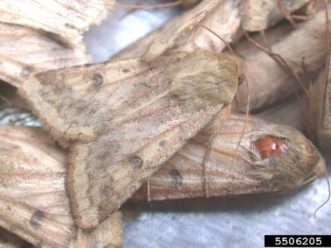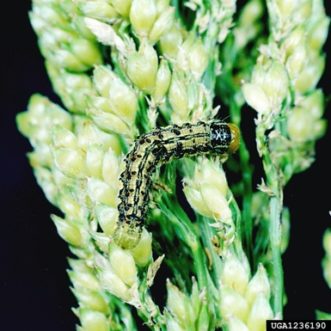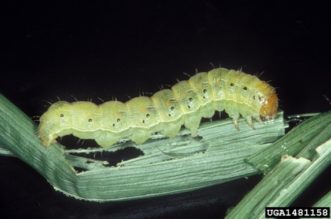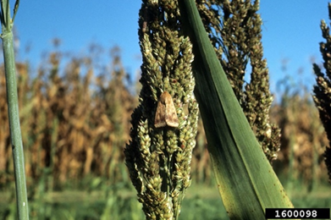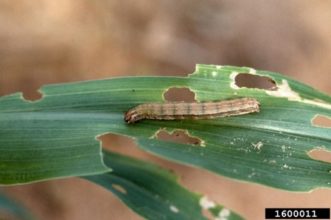Several species of lepidopteran larvae can infest and cause injury to sorghum grain heads. These include corn earworm, Helicoverpa zea, fall armyworm, Spodoptera frugiperda, and sorghum webworm, Nola sorghiella. These species often occur in tandem and are referred to as the headworm complex, feeding on maturing seed and potentially leading to yield loss. Corn earworm is the most commonly occurring species and is the largest, capable of feeding on a large amount of seed. Fall armyworms can also occur in large numbers in certain years. Sorghum webworms are more sporadic, generally only occurring in large numbers in wet years and in late-planted sorghum. While each of these pests can be sporadic in sorghum, all are capable of causing grain yield loss under the right conditions.1 Monitoring, scouting, and management of headworms are an important part of an integrated management plan for sorghum. This publication will help producers identify each of these pests, discuss the resulting injury, and identify a range of management considerations.
Description and Life Cycle
The corn earworm overwinters in the soil as a pupa. Each year, the first generations are often completed on wild hosts or corn, where population sizes can increase significantly, leading to larger populations moving into sorghum and other crops in subsequent generations. Corn earworm moths lay individual eggs either directly on the panicle or on leaves of sorghum. Moths are light brown in color and typically have a dark spot on the forewing and a dark band near the bottom margin (figure 1). Larvae vary in color from pale green to pinkish to dark brown, and the body is covered in dark hairs. Larvae have alternating bands of light and dark stripes along the length of the body (figure 2 and 3). Corn earworms are cannibalistic, which often limits the number of larvae per panicle.1
The fall armyworm has a subtropical distribution and migrates north to the United States each year, typically arriving in South Carolina around late May to early June.2 Moths are active in the evening and will lay egg masses indiscriminately on any part of the sorghum plant, including directly on the panicle (figure 4). Egg masses contain hundreds of eggs and are covered with a thick layer of white scales after they are laid. There are six larval instars or stages of development. First instars are greenish with a black head, and the head begins to turn orange as it develops into a second instar. As it matures, the top surface of the body turns brownish and white lines develop along the length of the body. Later stages of larvae can be distinguished from corn earworms by an inverted Y-shape on the head (figure 5 and 6). In addition, fall armyworms do not feel rough to the touch, as is the case with corn earworms.
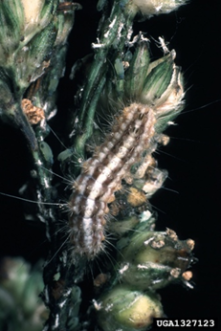
Figure 7. Sorghum webworm on panicle. Image credit: Alton N. Sparks, Jr., University of Georgia, Bugwood.org.
Sorghum webworms overwinter as larvae in host plant material or residues, although data are limited from South Carolina. They can produce as many as six generations a year, which can lead to large populations later in the season, especially in humid areas. Larvae are flattened and yellowish to greenish-brown in color and have four reddish to black stripes along the length of the body. They are covered in spines or hairs, giving them a similar appearance to corn earworms; however, webworm larvae will suspend themselves from a silken thread when disturbed. Webworms are also smaller than earworms and armyworms (figure 7).
Damage to Sorghum
Eggs can be laid in sorghum prior to heading, depending on planting date. Larvae of both corn earworms and fall armyworms will actively feed on foliage prior to panicle development. If foliage feeding occurs very early in whorl stages, it generally does not affect yield, as sorghum is very tolerant to defoliation. If there is significant foliage feeding later in the season, there is potential for it to reduce the grain yield, but this is a rare occurrence.3
The most significant damage caused by headworms is direct feeding on developing seed. Larvae chew circular holes in the seed and feed on the starchy contents, and the damaged seed will often be only partially consumed. Feeding typically begins on single seeds and will progress as larvae mature. Late instar larvae can feed on as many as twelve seeds in a twenty-four-hour period.1 Seed heads are most susceptible to injury during flowering through the milk stage of development, with earlier instar larvae preferring earlier stages of seed head development and larger larvae preferring the milk stage.4 The most significant damage is seen when infestations reach their peak around 50% bloom.3 Sorghum bloom begins when the seed head extends and begins to shed pollen starting from the top of the panicle moving towards the bottom. A sorghum plant is most susceptible to injury from headworms when around half of an individual panicle has bloomed.
Management
Cultural Control
The planting date can be adjusted to reduce the impact of headworm feeding on susceptible stages of sorghum. Later plantings are often more prone to high levels of injury, in particular from webworm feeding.5 Planting sorghum earlier will allow panicles to develop beyond the most susceptible stages (50% bloom) prior to peak headworm populations. Planting a sorghum variety with a more open seed head can improve predation of headworms and reduce the overall population in a field.1,5 Overwintering webworm populations can potentially be reduced by plowing or disking crop residue into the soil.
Chemical Control
Once sorghum begins blooming, insecticide treatments are often recommended when there are two or more large (> ½ in) corn earworm or fall armyworm larvae per grain head or five or more webworms per grain head.6-8 The economic injury level for smaller larvae is higher as they have a lower survival rate and do not cause the same level of damage as larger larvae. Sampling can be conducted by shaking seed heads over a bucket in several locations throughout the field and counting the total number of headworms. A sequential sampling has been developed and can be used to reduce scouting times. If there are more then 0.5 headworms per panicle in the first thirty panicles sampled, no additional scouting is needed.9
Insecticides from different classes that effectively control all species of headworms include some pyrethroids, organophosphates, chlorantraniliprole, and spinosad. Resistance to pyrethroids has been reported in some populations of webworms and fall armyworms. While all these insecticide classes can be used throughout the stages of development, spinosads are more effective when managing smaller larvae. It is important to consider beneficial insect populations when applying insecticides. Particularly if the field is also infested with sugarcane aphids, broad-spectrum insecticides such as pyrethroids and organophosphates will eliminate many beneficial insects, which can help to control sugarcane aphid as well as headworms.
References Cited
- Young W, Teets G. Sorghum entomology. Annual Review of Entomology. 1977;22:193–218.
- Sparks AN. A review of the biology of the fall armyworm. The Florida Entomologist. 1979;62(2):82–87. doi:10.2307/3494083.
- Starks K, Burton R. Damage to grain sorghum by fall armyworm and corn earworm. Journal of Economic Entomology. 1979;72(4):576–578. doi:10.1093/jee/72.4.576.
- Kinzer H, Henderson C. Damage by larvae of the corn earworm to grain sorghum. Journal of Economic Entomology. 1968;61(1):263–267. doi:10.1093/jee/61.1.263.
- Hobbs J, Teets G, Johnson J, Wuensche A. Management tactics for the sorghum webworm in sorghum. Journal of Economic Entomology. 1979;72(3):362–366.
- Buntin GD. Grain sorghum insect pests and their management. Athens (GA): University of Georgia Cooperative Extension; 2009. Bulletin 1283.
- Kinzer H, Henderson G. Effect of sorghum webworm on yield of grain sorghum in Oklahoma. Journal of Economic Entomology. 1967;60(1). doi:10.1093/jee/60.1.118
- Knutson AE, Cronholm G. 2007. Economic injury levels for sorghum midge, Stenodiplosis sorghicola and corn earworm, Helicoverpa zea, feeding on panicles of sorghum, Sorghum bicolor. Southwestern Entomologist. 2007;32: 75–85.
- Elliott N, Brewer MJ, Giles KL, Backoulou GF, McCornack BP, Pendleton BB, Royer TA. 2014. Sequential sampling for panicle caterpillars (Lepidoptera: Noctuidae) in sorghum. Journal of Economic Entomology. 2014;107: 846–853.

